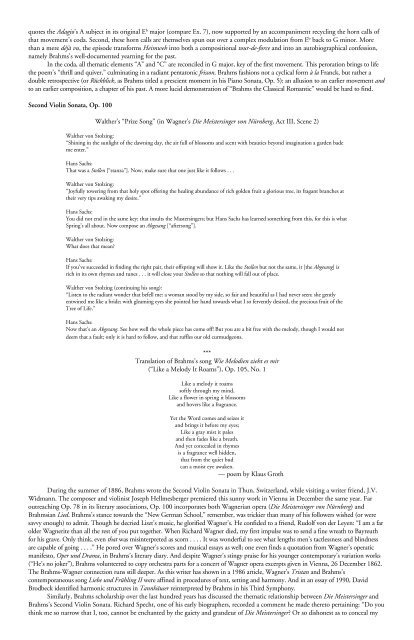You also want an ePaper? Increase the reach of your titles
YUMPU automatically turns print PDFs into web optimized ePapers that Google loves.
quotes the Adagio’s A subject in its original E b major (compare Ex. 7), now supported by an accompaniment recycling the horn calls of<br />
that movement’s coda. Second, these horn calls are themselves spun out over a complex modulation from E b back to G minor. More<br />
than a mere déjà vu, the episode transforms Heimweh into both a compositional tour-de-force and into an autobiographical confession,<br />
namely <strong>Brahms</strong>’s well-documented yearning for the past.<br />
In the coda, all thematic elements “A” and “C” are reconciled in G major, key of the first movement. This peroration brings to life<br />
the poem’s “thrill and quiver,” culminating in a radiant pentatonic frisson. <strong>Brahms</strong> fashions not a cyclical form à la Franck, but rather a<br />
double retrospective (or Rückblick, as <strong>Brahms</strong> titled a prescient moment in his Piano Sonata, Op. 5): an allusion to an earlier movement and<br />
to an earlier composition, a chapter of his past. A more lucid demonstration of “<strong>Brahms</strong> the Classical Romantic” would be hard to find.<br />
Second Violin Sonata, Op. 100<br />
Walther’s “Prize Song” (in Wagner’s Die Meistersinger von Nürnberg, Act III, Scene 2)<br />
Walther von Stolzing:<br />
“Shining in the sunlight of the dawning day, the air full of blossoms and scent with beauties beyond imagination a garden bade<br />
me enter.”<br />
Hans Sachs:<br />
That was a Stollen [“stanza”]. Now, make sure that one just like it follows . . .<br />
Walther von Stolzing:<br />
“Joyfully towering from that holy spot offering the healing abundance of rich golden fruit a glorious tree, its fragant branches at<br />
their very tips awaking my desire.”<br />
Hans Sachs:<br />
You did not end in the same key: that insults the Mastersingers; but Hans Sachs has learned something from this, for this is what<br />
Spring’s all about. Now compose an Abgesang [“aftersong”].<br />
Walther von Stolzing:<br />
What does that mean?<br />
Hans Sachs:<br />
If you’ve succeeded in finding the right pair, their offspring will show it. Like the Stollen but not the same, it [the Abgesang] is<br />
rich in its own rhymes and tunes . . . it will close your Stollen so that nothing will fall out of place.<br />
Walther von Stolzing (continuing his song):<br />
“Listen to the radiant wonder that befell me: a woman stood by my side, so fair and beautiful as I had never seen; she gently<br />
entwined me like a bride; with gleaming eyes she pointed her hand towards what I so fervently desired, the precious fruit of the<br />
Tree of Life.”<br />
Hans Sachs:<br />
Now that’s an Abgesang. See how well the whole piece has come off! But you are a bit free with the melody, though I would not<br />
deem that a fault; only it is hard to follow, and that ruffles our old curmudgeons.<br />
***<br />
Translation of <strong>Brahms</strong>’s song Wie Melodien zieht es mir<br />
(“Like a Melody It Roams”), Op. 105, No. 1<br />
Like a melody it roams<br />
softly through my mind,<br />
Like a flower in spring it blossoms<br />
and hovers like a fragrance.<br />
Yet the Word comes and seizes it<br />
and brings it before my eyes;<br />
Like a gray mist it pales<br />
and then fades like a breath.<br />
And yet concealed in rhymes<br />
is a fragrance well hidden,<br />
that from the quiet bud<br />
can a moist eye awaken.<br />
— poem by Klaus Groth<br />
During the summer of 1886, <strong>Brahms</strong> wrote the Second Violin Sonata in Thun, Switzerland, while visiting a writer friend, J.V.<br />
Widmann. The composer and violinist Joseph Hellmesberger premiered this sunny work in Vienna in December the same year. Far<br />
outreaching Op. 78 in its literary associations, Op. 100 incorporates both Wagnerian opera (Die Meistersinger von Nürnberg) and<br />
<strong>Brahms</strong>ian Lied. <strong>Brahms</strong>’s stance towards the “New German School,” remember, was trickier than many of his followers wished (or were<br />
savvy enough) to admit. Though he decried Liszt’s music, he glorified Wagner’s. He confided to a friend, Rudolf von der Leyen: “I am a far<br />
older Wagnerite than all the rest of you put together. When Richard Wagner died, my first impulse was to send a fine wreath to Bayreuth<br />
for his grave. Only think, even that was misinterpreted as scorn . . . . It was wonderful to see what lengths men’s tactlessness and blindness<br />
are capable of going . . . .” He pored over Wagner’s scores and musical essays as well; one even finds a quotation from Wagner’s operatic<br />
manifesto, Oper und Drama, in <strong>Brahms</strong>’s literary diary. And despite Wagner’s stingy praise for his younger contemporary’s variation works<br />
(“He’s no joker”), <strong>Brahms</strong> volunteered to copy orchestra parts for a concert of Wagner opera excerpts given in Vienna, 26 December 1862.<br />
The <strong>Brahms</strong>-Wagner connection runs still deeper. As this writer has shown in a 1986 article, Wagner’s Tristan and <strong>Brahms</strong>’s<br />
contemporaneous song Liebe und Frühling II were affined in procedures of text, setting and harmony. And in an essay of 1990, David<br />
Brodbeck identified harmonic structures in Tannhäuser reinterpreted by <strong>Brahms</strong> in his Third Symphony.<br />
Similarly, <strong>Brahms</strong> scholarship over the last hundred years has discussed the thematic relationship between Die Meistersinger and<br />
<strong>Brahms</strong>’s Second Violin Sonata. Richard Specht, one of his early biographers, recorded a comment he made thereto pertaining: “Do you<br />
think me so narrow that I, too, cannot be enchanted by the gaiety and grandeur of Die Meistersinger? Or so dishonest as to conceal my


